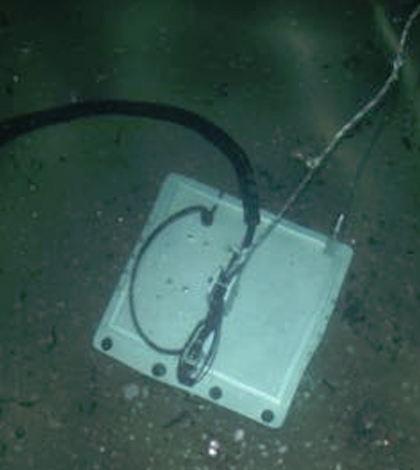VIMS scientists develop ROV to help monitor oil spills

The Acoustic Slick Thickness ROV moves in a research tank on the campus of the Virginia Institute of Marine Science. (Credit: David Malmquist)
Scientists at the Virginia Institute of Marine Science are working to develop an underwater robot to aid in the cleanup of oil spills, according to a release from the College of William & Mary. The prototypical device uses sound waves to help judge different aspects of oil slicks.
Other methods to judge the volume, extent or thickness of a spill typically just involve visual inspections. The remotely operated vehicle in development at VIMS, called the Acoustic Slick Thickness ROV, will better those inspections by using acoustic technology to locate and assess spills more quickly and easily.
VIMS scientists are developing the new ROV at the Ohmsett Wave Tank, which is maintained at the National Oil Spill Response Research and Renewable Energy Test Facility.
“Our ROV will measure the thickness of experimental slicks at Ohmsett to aid in developing and testing oil spill response tools,” said Paul Panetta, an adjunct professor at VIMS, in the release. “It will also provide a test platform for developing other sensors and for field applications.”
The ROV has four acoustic transducers that send and receive sound waves to take measurements. The waves bounce off of changing densities between oil, water and ice. Delays between response times allow the vehicle to gauge the thickness of slicks down to a half millimeter. That may not sound like much, but when the precision is applied to large spills like those that have covered the Gulf of Mexico, a half-millimeter difference can mean a lot more oil in the water.

The electronic signal of an acoustic echo is shown as the Acoustic Slick Thickness ROV detects oil in a research tank. (Credit: David Malmquist)
The device is also outfitted with cameras to help operators control where it goes. It depends on rolling tracks beneath its structure for movement and is linked to researchers driving it by a cable system.
“We built the ROV around waterproof motorized tracks,” said Panetta. “These are rated to a depth of 100 feet, have a top speed of 32 feet per minute and can each pull up to 100 pounds.”
An integrated thermometer on the ROV is also important because water temperature affects the speed at which acoustic waves can travel in water. If their speed changes, then the ROV must be able to account for that and adjust the data it’s reporting on slick thickness.
Next steps for the VIMS team is to improve the prototype’s setup so that it can get out of the test tank and help respond to an actual oil spill in the ocean.
“We’ve already thought of several improvements, including integrating the video stream into the ROV software for more seamless operation,” said Panetta. “We’d also like to create a database of the acoustic properties of different types of oil as a function of temperature.”
Researchers say the technology could one day be mounted to autonomous underwater vehicles or other free-floating platforms in the future.
Top image: The Acoustic Slick Thickness ROV moves in a research tank on the campus of the Virginia Institute of Marine Science. (Credit: David Malmquist)





0 comments